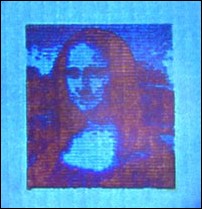This article can be printed on a hair
1. 1. 2016 | Technical University of Denmark | www.dtu.dk
Thanks to a new revolutionary laser printing technology, it is now possible to print this press release in colour on an area no bigger than a hair. This breakthrough in nanotechnology will be published on 14 December 2015 in an article in the scientific journal Nature Nanotechnology.
 Using this new technology, DTU researchers from DTU Nanotech and DTU Fotonik have reproduced a colour image of Mona Lisa which is less than one pixel on an iPhone Retina display. The laser technology allows printing in a mind-blowing resolution of 127,000 DPI. In comparison, weekly or monthly magazines are normally printed in a resolution equivalent to 300 DPI.
Using this new technology, DTU researchers from DTU Nanotech and DTU Fotonik have reproduced a colour image of Mona Lisa which is less than one pixel on an iPhone Retina display. The laser technology allows printing in a mind-blowing resolution of 127,000 DPI. In comparison, weekly or monthly magazines are normally printed in a resolution equivalent to 300 DPI.
Printing the microscopic images requires a special nanoscale-structured surface. The structure consists of rows with small columns with a diameter of merely 100 nanometres each. This structured surface is then covered by 20 nanometres of aluminium. When a laser pulse is transmitted from nanocolumn to nanocolumn, the nanocolumn is heated locally, after which it melts and is deformed. The temperature can reach up to 1,500 °C, but only for a few nanoseconds, preventing the extreme heat from spreading.
The intensity of the laser beam determines which colours are printed on the surface, since the extent of column deformation decides which colour is reflected. Low-intensity laser pulses lead to a minor deformation of the nanocolumn, resulting in blue and purple colour tone reflections. Strong laser pulses create a drastic deformation, which gives the reflection from the nanocolumn an orange and yellow colour tone.
The DTU researchers believe that there is considerable scope for application of the new laser printing technology.
Read more at www.dtu.dk
Image Credit: Technical University of Denmark




